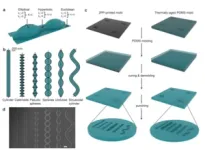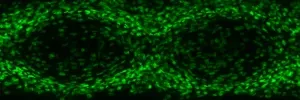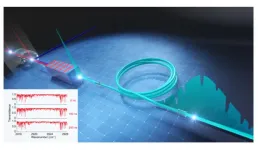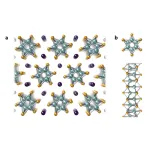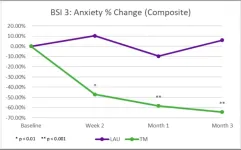(Press-News.org) BIRMINGHAM, Ala. – Obese fruit flies are the experimental subjects in a Nature Communications study of the causes of muscle function decline due to obesity. In humans, skeletal muscle plays a crucial role in metabolism, and muscle dysfunction due to human obesity can lead to insulin resistance and reduced energy levels.
Interestingly, studies in various animal models have shown that time-restricted feeding — a natural non-pharmaceutical intervention — protects against obesity, aging and circadian disruption in peripheral tissues such as skeletal muscle. However, the mechanisms underlying those benefits were not known.
In fruit flies — scientifically known as Drosophila melanogaster — obese Drosophila that are subjected to obesogenic challenges and treated with time-restricted feeding have shown improved muscle performance, reduced intramuscular fat, lowered levels of phospho-AKT and a reduction in the marker of insulin resistance. Intramyocellular lipids and triglycerides deposited within skeletal muscle cells can be harmful if not routinely depleted.
The current study, led by University of Alabama at Birmingham researcher Girish Melkani, Ph.D., provides a potential mechanistic basis for the benefits mediated by time-restricted feeding. Melkani and colleagues found that time-restricted feeding induced upregulation in genes related to glycine production and utilization, and downregulation of a key enzyme involved in triglyceride synthesis, in all time-restricted feeding conditions.
Additionally, time-restricted feeding induced upregulation in genes and increases in metabolites related to the purine cycle in the high-fat diet fruit fly model of obesity, and it led to upregulation of genes and increases in metabolites relating to glycolysis, glycogen metabolism, the tricarboxylic acid cycle and the electron transport chain connected by AMP kinase signaling, in a genetic fruit fly model of obesity mutated in sphingosine kinase, or Sk2.
“The prevalence of obesity continues to be a worldwide growing issue associated with crippling health care and economic burdens,” said Melkani, an associate professor in the UAB Department of Pathology Division of Molecular and Cellular Pathology. “Obesity is associated with various comorbidities, especially high-caloric diets and genetic predisposition. This study elucidates potential mechanisms behind time-restricted feeding’s protective properties against skeletal muscle dysfunction and metabolic impairment induced by obesity.”
The findings may pave the way for future time-restricted feeding studies in muscle, providing a natural and affordable form of alternative therapy for managing pathologies related to metabolism and obesity, Melkani says.
Melkani also described his long-term research goals. “Recent genome-wide association studies and exon sequencing approaches have identified a linkage of additional genes with genetic obesity. Obesity is strongly linked with cardiovascular disease and dementia. However, the mechanistic linkage remains poorly understood, and urgent interventions are required to mitigate these disorders.
“Our mechanistic approach — along with interventions including time-restricted eating — will be highly useful in addressing and treating the obesity, cardiovascular disease and dementia disparities seen in the Deep South.”
The fruit fly is an amenable model for studying human metabolic diseases. In the current study, the high-fat diet fruit fly model of obesity has a diet that is supplemented with 5 percent coconut oil, and the fruit flies are allowed to feed 24 hours a day. The time-restricted feeding, high-fat diet fruit flies have access to the high-fat diet only 12 hours a day. The Sk2 fly model of obesity has a mutation in the Sk2 gene, leading to a hallmark accumulation of ceramide, which is implicated as a contributor to obesity.
Experimental methods for muscle performance in the current study included flight tests where 10 to 20 fruit flies are released into a Plexiglas box, and each fly’s ability to fly up, horizontally, down or not at all is measured. Methods also included cytological analysis of muscle tissue and abdomen fat bodies, gene expression analyses, and measurement of glycine, ATP and metabolite levels.
Co-first authors of the study, “Time-restricted feeding promotes muscle function through purine cycle and AMPK signaling in Drosophila obesity models,” are Christopher Livelo and Yiming Guo, graduate students in the UAB Department of Pathology.
Co-authors with Melkani, Livelo and Guo are Farah Abou Daya and Vasanthi Rajasekaran, UAB Department of Pathology; Shweta Varshney, Hiep D. Le and Satchidananda Panda, Salk Institute for Biological Studies, La Jolla, California; and Stephen Barnes, UAB Department of Pharmacology and Toxicology.
Support came from National Institutes of Health grants AG065992 and AG068550, UAB Startup Funds 3123226 and 3123227, and grants from the Wu-Tsai Human Performance Alliance and the Wu-Tsai Foundation.
At UAB, Pathology, and Pharmacology and Toxicology are departments in the Marnix E. Heersink School of Medicine.
END
Rhythmic eating pattern preserves fruit fly muscle function under obese conditions
Mechanistic findings in this study may pave the way for future time-restricted feeding studies in muscle, providing a natural and affordable form of alternative therapy for managing pathologies related to metabolism and obesity
2023-03-04
ELSE PRESS RELEASES FROM THIS DATE:
New tool for organ repair: Curvature of the environment
2023-03-04
A ball, a saddle, or a flat plate. The curvature of biomaterials inhibits or stimulates bone cells to make new tissue. This is what TU Delft engineers show in research published on Friday, 3rd of March in Nature Communications. This study of geometries could be an important step in research into repairing damaged tissues.
Living cells can perceive and respond to the geometry of their environment. ‘Cells sense and respond to the geometry of the surfaces they are exposed to. Depending on their curvature, surfaces can either encourage cells to create new tissue or prevent them from doing so,’ says Amir Zadpoor, ...
Military veterans face increased risk of HPV-related cancer due to low vaccination rates
2023-03-04
Human papillomavirus (HPV) vaccination rates among eligible veterans and active-duty military are half that of their civilian peers, putting them at greater risk of HPV-related cancers. That’s according to a new study published today in JAMA Oncology that provides the first national estimate of HPV vaccination rates in this population.
“Our findings should serve as a call to action to the Department of Defense and the Veterans Health Administration to advocate that their service members get vaccinated,” said senior author José P. Zevallos, ...
Innovative technology shows great promise against certain head and neck cancers
2023-03-04
Over the past decade, human papillomavirus (HPV) has increasingly been identified as a significant cause of certain head and neck cancers – for example, evidence suggests it causes 70% of oropharyngeal cancers in the United States.
Further, over the past three decades, incidence of HPV-driven cancers has increased substantially worldwide and in the U.S. While there are well-established screening tools, as well as vaccines, for HPV-driven cancers such as cervical cancer, there are fewer resources for HPV-driven head and neck cancers. As a result, researchers are working with a sense of urgency to develop innovative ...
Study shows those infected with COVID in the first wave in 2020 were 40% less likely than those who were not to get COVID-19 during the first six months of Omicron activity
2023-03-04
**Note: the release below is a special early release from the European Congress of Clinical Microbiology & Infectious Diseases (ECCMID 2023, Copenhagen, 15-18 April). Please credit the conference if you use this story**
Compared to adults who did not have COVID in the first wave (March to September 2020), adults infected with COVID-19 in that first wave were 40% less likely to become infected during the first six months of Omicron activity (December 2021 to May 2022), concludes a new Canadian study to be presented at this year’s European Congress of Clinical Microbiology & Infectious Diseases (ECCMID) in Copenhagen, Denmark (15-18 April). The study was led ...
Detecting the molecular vibration information faster and better by “stretching” time
2023-03-04
Infrared spectroscopy is a non-invasive tool to identify unknown samples and known chemical substances. It is based on how different molecules interact with infrared light. You may have seen this tool at airports, where they screen for illicit drugs. The technique has many applications: liquid biopsy, environmental gas monitoring, contaminant detection, forensic analyses, exoplanet search, etc. But the traditional infrared spectroscopy methods provide low (temporal) resolution data. They are usually only applied for static samples because spectral data acquisition is a slow process. Detecting fast-changing phenomena ...
Scientists thread rows of metal atoms into nanofiber bundles
2023-03-04
Tokyo, Japan – Researchers from Tokyo Metropolitan University have successfully threaded atoms of indium metal in between individual fibers in bundles of transition metal chalcogenide nanofibers. By steeping the bundles in indium gas, rows of atoms were able to make their way in between the fibers to create a unique nanostructure via intercalation. Through simulations and resistivity measurements, individual bundles were shown to have metallic properties, paving the way for application as flexible nanowires in nanocircuitry.
Atomic wires of transition metal chalcogenides (TMCs) ...
Intellifoods Labs, LLC strengthens partnership with Mason scientists to reduce food bacterial contamination detection time
2023-03-03
Mason Associate Professor of Infectious Diseases and Microbiology, Ramin M. Hakami has received a total of $35,000 in grants from Intellifoods Labs, LLC to continue examining methods to reduce the time to detect the presence of bacteria in food samples.
Numbers and types of foodborne disease occurrences have increased over time and are a major global public health concern. Hakami and his team seek to reduce the time to identify both live and dead bacteria in food samples using fluorescence detection. The team aims to optimize the detection ...
Transcendental Meditation highly effective in rapidly reducing healthcare worker burnout symptoms during the height of the Covid crisis
2023-03-03
Healthcare providers (HCP) at three Miami hospitals during the height of the Covid crisis, who practiced the Transcendental Meditation technique (TM), showed a rapid and highly significant reduction in stress-related burnout symptoms such as somatization, depression, anxiety, sleep disturbances, and emotional exhaustion, as well as significant improvement in mental well-being, compared to a parallel matched lifestyle-as-usual group (LAU), according to a new study published today in PLOS ONE.
A total of 65 healthcare providers at the three Miami hospitals (Baptist, ...
Unique hybrid reefs deployed off Miami Beach
2023-03-03
The first piece of a series of concrete structures was lowered into the water off the coast of Miami Beach on Wednesday morning, a massive crane on the deck of a floating barge hoisting the unit into the air and sinking it to the seabed.
During the next six hours, crewmembers aboard the barge would repeat that process until the structures, some stacked on top of each other, were settled on the seafloor, 14 feet below the surface.
To casual observers onshore, the daylong operation might have seemed routine. But this maritime activity was hardly run-of-the-mill.
In ...
Scientist to launch interstellar space music
2023-03-03
A scientist from Anglia Ruskin University (ARU) will premiere a new piece of music at the SXSW EDU festival that has been created using data beamed back to Earth from interstellar space.
On Thursday, 9 March, Dr Domenico Vicinanza will be joined on stage in Austin, Texas, by Dr Alyssa Schwartz, Visiting Assistant Professor of Flute and Musicology at Fairmont State University, to perform music shaped by scientific readings collected by NASA’s Voyager 1 spacecraft.
Dr Vicinanza, a Senior Lecturer in ARU’s School of Computing and Information Science, is a leading expert ...
LAST 30 PRESS RELEASES:
University of Oklahoma researcher awarded funding to pursue AI-powered material design
Exploring how the visual system recovers following injury
Support for parents with infants at pediatric check-ups leads to better reading and math skills in elementary school
Kids’ behavioral health is a growing share of family health costs
Day & night: Cancer disrupts the brain’s natural rhythm
COVID-19 vaccination significantly reduces risk to pregnant women and baby
The role of vaccination in maternal and perinatal outcomes associated with COVID-19 in pregnancy
Mayo Clinic smartwatch system helps parents shorten and defuse children's severe tantrums early
Behavioral health spending spikes to 40% of all children’s health expenditures, nearly doubling in a decade
Digital cognitive behavioral treatment for generalized anxiety disorder
Expenditures for pediatric behavioral health care over time and estimated family financial burden
Air conditioning in nursing homes and mortality during extreme heat
The Alps to lose a record number of glaciers in the next decade
What makes a good proton conductor?
New science reporting guide published for journalists in Bulgaria
New international study reveals major survival gaps among children with cancer
New science reporting guide published for journalists in Turkey
Scientists develop a smarter mRNA therapy that knows which cells to target
Neuroanatomy-informed brain–machine hybrid intelligence for robust acoustic target detection
Eight SwRI hydrogen projects funded by ENERGYWERX
The Lundquist Institute and its start-up company Vitalex Biosciences Announces Strategic Advancement of Second-Generation fungal Vaccine VXV-01 through Phase 1 Trials under $40 Million Competitive Con
Fine particles in pollution are associated with early signs of autoimmune disease
Review article | Towards a Global Ground-Based Earth Observatory (GGBEO): Leveraging existing systems and networks
Penn and UMich create world’s smallest programmable, autonomous robots
Cleveland researchers launch first major study to address ‘hidden performance killer’ in athletes
To connect across politics, try saying what you oppose
Modulating key interaction prevents virus from entering cells
Project explores barriers to NHS career progression facing international medical graduates
Jeonbuk National University researchers explore the impact of different seasonings on the flavor perception of Doenjang soup
Two Keck Medicine of USC Hospitals named Leapfrog Top Teaching Hospitals
[Press-News.org] Rhythmic eating pattern preserves fruit fly muscle function under obese conditionsMechanistic findings in this study may pave the way for future time-restricted feeding studies in muscle, providing a natural and affordable form of alternative therapy for managing pathologies related to metabolism and obesity

